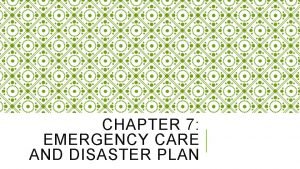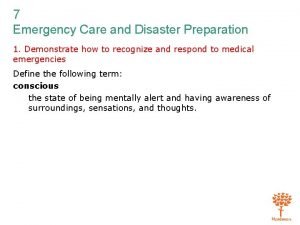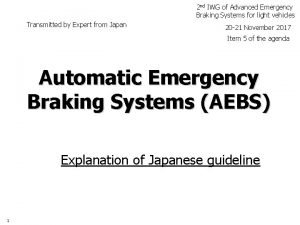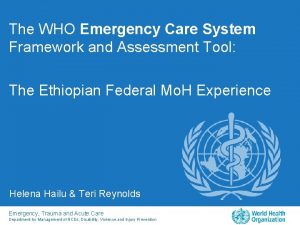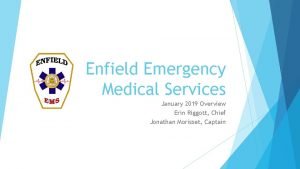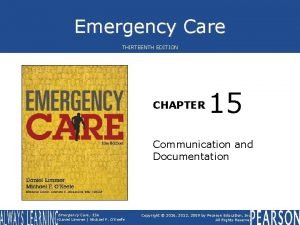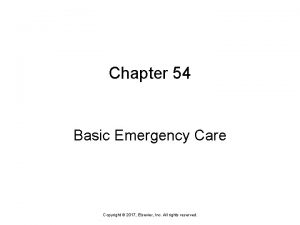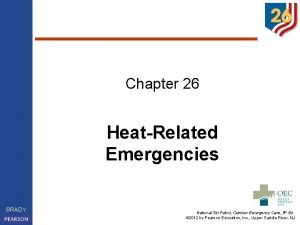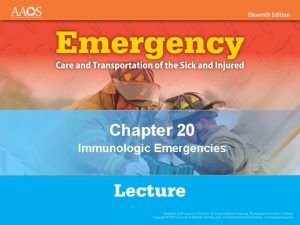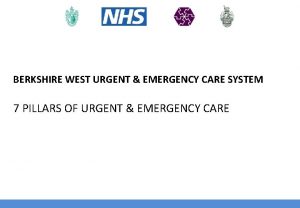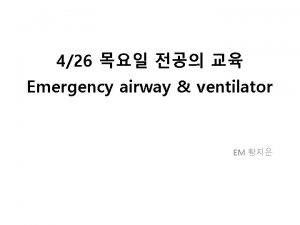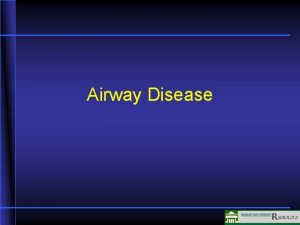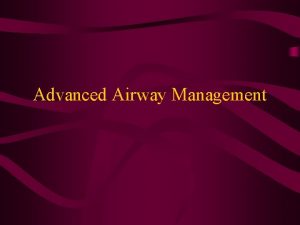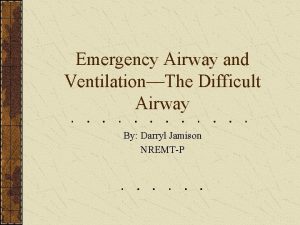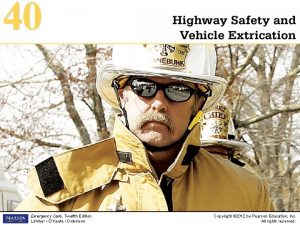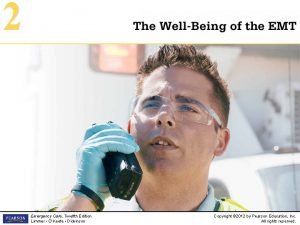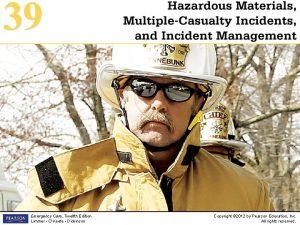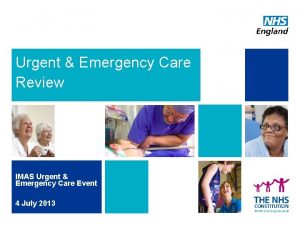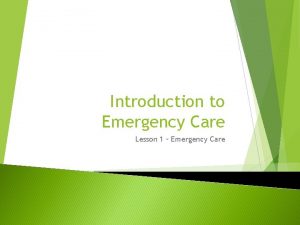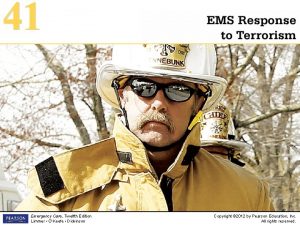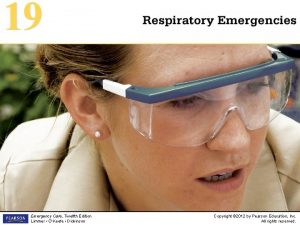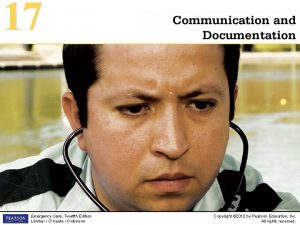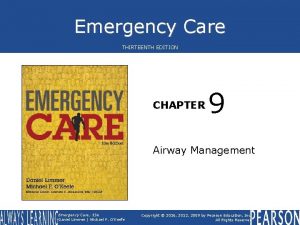1 Essential Emergency Airway Care Airway Preparation Andrew


















- Slides: 18

#1 Essential Emergency Airway Care. Airway Preparation Andrew Brainard, MD, MPH, FACEM www. thesharpend. org abrainard 01@gmail. com 1

#1 Pre-arrival preparation of Team, Plan, Room, and Equipment • Learning Objectives: • – Prepare TEAM • • • Assign team leader (jacket, roles, plan) Primary airway operator Backup airway operator Airway assistant Drug provider – Basic Pre-Arrival PLAN – No signs of trauma, OSA – GCS 5, RR 6, Sa. O 2 88%, pulse 100, BP 100/60. • • Possible A, B, C, and D • Likely Medications • Ensure team members understand • are skilled in their roles – Prepare ROOM • Move bed, Resus tower, and Airway cart – Prepare EQUIPMENT • • • Monitor BVM, Adjuncts, Oxygen, Suction Laryngoscopes, ETT, Bougie Backups (SGA/Video/Cric) Drugs R 40: 50 y/o F found down and unresponsive at home. Team should prepare for critical patient – – Team Plan Room Equipment Conduct a Detailed Tour of ED resus area – – – – – Wear Jacket Bed (Move Bed, Apply Brakes, Head Elevation) Resus Tower (BVM, Suction, Oxygen, Sa. O 2, ET CO 2) Airway Cart (Top Through Bottom Drawer) Medications (Cart, Intubation Box, Pyxis) Airway Aids (Posters, Checklist) Video laryngoscope Ventilators, CPAP/Bi. Level Store Room • Trach, spare ETT, other supplies – Paed Dose Calculator on Computer

Managing the Airway Team 3

4

Medications t n a t s i • Team Leader • Primary Airway Operator ss A y Primary Airway Operator a w Air Backup Airway Operator – Backup Airway Operator • Airway Assistant • Manual In-line Stabilization Drugs • Drug Provider • Runner/Scribe/Other • Intensive Care Team Leader Intensive Care 5

Preparing the room and equipment • Locate your personnel – – Resus Nurse(s) ED SMO(s) ED Reg(s) Charge Nurse • ICU • Anesthetics • Prepare the Room – Move the bed – Move the airway cart – Move the resus tower • Prepare the Resus Tower – Prepare the Monitor • Prepare the Airway Cart • Drugs • Locate your backup stuff – Video-laryngoscope etc. . 6

Preparing the Resus Tower and Monitoring 1 st monitor on Sa. O 2 Not on BP arm ETCo 2 Tested On BVM 2 nd monitor on Tower Suction Tested Under Pt’s R shoulder Oxygen Mask Nasal BVM O 2 on Reservoir bag PEEP 7

Preparing the Airway Cart • Cart Location • Top – Set up as needed • Side – Bougie, Tube Exchanger • 1 st Drawer – Adjuncts: OPA, NPA, Suction, Mask • 2 nd & 3 rd Drawer Cart Airway cts Adjun x 2 oscope Laryng ETT x 2 /Stylet Bougie tie yringe/ Lube/s ric LMA/C Suction – Pt’s right – Orientation (able to open drawer) – Primary: Laryngoscopes, ETCo 2, 3 rd Drawer – ETT, Tie • 4 th Drawer – Air. Q SGA (3 sizes) w/ stabilizer • 5 th Drawer – I-LMA, I-LMA ETT, w/ stabilizer • Bottom drawer – Scalpel – Cric Pack • pen, scalpel, 6 -0 cuffed ETT, disinfectant, gauze, lube, – Cook Melker Surgical + Percutaneous Cric Kit 8

Important Equipment Checks: Resus Tower/Gantry Medications Suction Oxygen Mask/BMV/Nasal RSI meds Oxygen Power Cart Airway cts Adjun Sa 2 ETCo G C E BP/ x 2 oscope Laryng ETT x 2 /Stylet Bougie tie yringe/ Lube/s ric LMA/C Suction Ventilator itor Mon O 2 Videoscope ETT Stylet On Circulation 2 nd Monitor IV Fluids A-lines Room Bed Position Height Locked Tower Position Height Videoscope Monitoring 1 st monitor on Sa. O 2 Not on BP arm ETCo 2 Tested On BVM nd 2 monitor on Tower/Gantry Suction Tested Under R shoulder Oxygen Mask BVM Nasal BVM O 2 Reservoir bag PEEP Cart Top Adjuncts (OPA/NPA) Laryngoscope Lights tested 2 sizes ETT Lubed Stylet shaped Smaller size ready Syringe/tie Drawers LMA/Air. Q sized Cric kit located 9

Medications Prep RSI meds Prep IV fluid Prep maintenance meds *Airway Assistant* *Primary Airway Operator* Assure oxygenation Formal airway assessment Vocalize plan A, B, C, D Primary airway procedure Prep airway table Suction, Adjuncts, Laryngoscopy, ETT, Bougie, LMA, Cric Kit, Place nasal O 2 External laryngeal manipulation Handles tube/bougie Assists with securing tube Monitoring Prep Room Monitoring Sa. O 2, ETCo 2, BP, ECG Intensive Care Continuity of Care Transport *Backup Airway Operator* Examine patient Position patient External laryngeal manipulation Backup airway procedures Perform cricothyroidotomy *Drugs* IV/IO x 2 Administer RSI meds Team Leader Prepare room/staff Leads resuscitation 10

Indications for advanced airway management • Goals of Care – Non-futile treatment – Able to complete continuity of care • Unprotected airway – Obtunded, GCS <8, Cardiac arrest, Trauma • Oxygenation or ventilation – Not appropriate for BVM/CPAP/Bi. Level • Clinical course – Agitated patient needing sedation for patient and staff safety – Expected future airway difficulty • trauma, burns, infection, angioedema – Need for pain control in patients during future procedures • Theatre, CT, etc. – Expected multi-organ failure or severe sepsis 11

Different urgency of airway control • Crash– Extreme time pressure – Forced-to-act • Difficulty oxygenating and ventilating • Emergent– Substantial time pressure – Can be oxygenated • Allows for some preplanning and preparation • Semi-Elective– Minimal time pressure on stable patient • Full assessment and planning time 12

Airway Assessment • MOANS (Mask) – – – M: mask seal O: obstruction / obesity A: age (>55) N: no teeth S: stiff lungs or c-spine • LEMON (Intubation) – L: look – E: evaluate 3 -3 -2 – M: mallampati – O: obstruction / obesity – N: neck • RODS (SGA/LMA) – – R: restricted mouth O: obstruction D: disrupted or distorted S: stiff lungs or c-spine • SHORT (Surgical Airway) – – – S: surgery H: haematoma O: obesity R: radiation T: tumor 13

Airway Assistant Drugs Primary Airway Operator Team Leader *Confirm that people understand their roles* Primary • Formal Airway Assessment** • Plan A, B, C, D • Pullout Criteria Backup • Backup Criteria • Cric plan Airway Assistant Drugs • External Laryngeal • Access Manipulation • Drugs • Bougie/tube • Dose procedure • Equipment names & sizes 14

The Pre-arrival briefing Direct laryngoscopy bougie+7. 5 tube • We have a 40 y/o female who has taken a large poly-overdose with a decreased level of responsiveness. She is reported to have vomited several times and is ventilating poorly. • If we think airway management is indicated and our formal airway assessment indicates it is appropriate to proceed, our plan will be to intubate her. • The team will be: – Me as team leader – Fred as primary airway operator – Linda as backup airway operator – Viola as airway assistant – I will also push the drugs Video laryngoscopy stylet+7. 5 tube Air. Q 3. 5 • Assuming no contraindications, we will RSI with Thio and Sux, with dose to be determined. • Our plan will be: A- Direct laryngoscopy with bougie+7. 5 tube B- Video laryngoscopy with stylet+7. 5 tube C- Air. Q size #3. 5 D- Cric for Sats <80% and dropping • We will use all our “best practice” techniques. *Confirm that people understand their roles* Primary • Formal Airway Assessment** • Plan A, B, C, D • Pullout Criteria Backup • Backup Criteria • Cric plan Airway Assistant • External Laryngeal Manipulation • Bougie/tube procedure • Equipment names & sizes Drugs • Access • Drugs • Dose • Everyone understand their roles? • Questions or suggestions? • Let’s make sure everything is ready for this patient’s arrival. 15

16

Tips for managing the team • • Knowledge Experience Respect Seniority Mannerisms Age Gender • • • Introduce yourself Ask for everyone’s name Assign roles Preplan Practice Volume 17

Brief Preparation References: • George Kovacs and J. Adam Law: Airway Management in Emergencies, 2 nd Ed, 2011 • Walls RM and Murphy MF. Manual of Emergency Airway Management, 4 th Ed, 2012 • Chris Nickson: Own the Airway- Life in the Fast Lane (http: //lifeinthefastlane. com/own-the-airway/) (accessed on 15/6/2014) • Reuben Strayer. Free Emergency Medicine Talks: Contemporary Strategies in Airway Management http: //freeemergencytalks. net/wp-content/uploads/2012/07/2012 -06 -29 -D 3 T 3 -1430 -Contemporary -Strategies-in-Airway-Management. mp 3 (Accessed on 1/06/13) • Tim Leeuwenburg. SMACCGold: Checklists in Airway Management (http: //vimeo. com/89997364) (18 min) (accessed on 15/6/2014) • The Difficult Airway Society Guidelines (http: //www. das. uk. com/guidelineshome. html) (accessed on 15/6/2014) • Nicholas Chrimes & Peter Fritz- The Vortex Approach http: //www. vortexapproach. com/Vortex_Approach/Vortex. html (accessed on 15/6/2014) • Javier Benitez, Academic life in emergency medicine. Mnemonics for difficult airway predictorshttp: //academiclifeinem. com/mnemonics-for-difficult-airway-predictors/ (accessed on 15/6/2014) 18
 Upper airway and lower airway
Upper airway and lower airway Emergency care and disaster preparation chapter 7
Emergency care and disaster preparation chapter 7 Emergency care and disaster preparation
Emergency care and disaster preparation Primary secondary tertiary health care definition
Primary secondary tertiary health care definition Advanced emergency braking system
Advanced emergency braking system Essential non essential fatty acids
Essential non essential fatty acids Emergency care system framework
Emergency care system framework Prehospital emergency care 10th edition
Prehospital emergency care 10th edition Therapeutic communication techniques
Therapeutic communication techniques Injuries first aid
Injuries first aid Enfield ems
Enfield ems Emergency care 13th edition chapter 1
Emergency care 13th edition chapter 1 Chapter 54 basic emergency care
Chapter 54 basic emergency care Outdoor emergency care 6th edition
Outdoor emergency care 6th edition Care for a victim of an immunologic emergency
Care for a victim of an immunologic emergency Emergency care newbury
Emergency care newbury Emergency care first aid and disasters
Emergency care first aid and disasters Prehospital emergency care 11th edition
Prehospital emergency care 11th edition Prehospital emergency care 11th edition study guide
Prehospital emergency care 11th edition study guide

